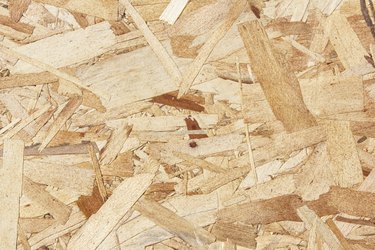
Oriented strand board, plywood and particleboard are all fabricated wood products, made by fastening pieces of wood into a solid form. Plywood is made by gluing together thin sheets of wood veneer with grains alternating. OSB and particleboard are both made of chips or flakes, but the pieces in OSB are larger and carefully oriented to provide an alternating grain pattern like plywood. Particleboard is made of smaller chips, even sawdust.
OSB More Common
Video of the Day
Plywood was once the traditional substitute for solid wood in flooring sheds and other buildings, but OSB has become more common. In 2006, manufacturers produced 26 million square feet of OSB and 16 million square feet of plywood. A major reason is cost: OSB is typically far less expensive than plywood of comparable size. Particleboard also is cheap but lacks the strength of plywood or OSB.
Video of the Day
Larger OSB Panels
OSB and plywood are both commonly sold in 4-by-8-foot sheets, but OSB can be made in much larger panels, up to 8-by-24 feet. Using larger OSB panels can be an advantage when flooring a big or odd-size shed, reducing the number of joints in a floor. Structurally, OSB and plywood are very similar in strength and ability to hold nails or screws; OSB may have greater shear strength -- the ability to span distances -- than comparable thickness of plywood. Plywood shed flooring is usually 3/4 inch and OSB 5/8 inch thick.
Subject to Moisture
The major disadvantage of OSB as shed flooring is that it is more susceptible to moisture, especially at the edges. Edges, when wet, can swell up to 15 percent, opening the way for water to get into other shed elements and eventually causing the OSB and other wood to deteriorate. Plywood expands evenly when wet, dries more quickly and returns to its original shape, which can be somewhat overcome in a shed floor with thorough sealing or painting and protection from moisture underneath by elevating the floor.
Tongue-and-Groove Style
A tongue-and-groove style of OSB is best for shed flooring. These panels have a protrusion, or tongue, on one edge, which fits into a slot or groove on an adjoining panel, adding strength to the connection and also reducing the chance of moisture penetration. OSB flooring in a shed can support heavy weights, such as large lawn implements or tool cabinets. OSB has a rough side and a smooth side and should be installed as flooring with the smooth side up to reduce chances of flaking and chipping.